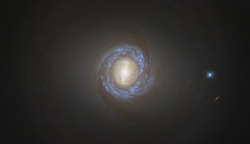| NGC 1317 | |
|---|---|
 The contrasting galaxies NGC 1316 and 1317 | |
| Observation data (J2000 epoch) | |
| Constellation | Fornax |
| Right ascension | 03h 38.5m [1] |
| Declination | −35° 27′ [1] |
| Distance | from 17 megaparsecs (55 Mly) to 26.9 megaparsecs (88 Mly) |
| Apparent magnitude (V) | 11.0 [1] |
| Characteristics | |
| Type | SBa [1] |
| Apparent size (V) | 2.8′ × 2.4′ [1] (55,000 light-years in diameter) |
| Notable features | Large uncertain of distance |
| Other designations | |
| ESO 357-23, IRAS 03208-3716, MCG -6-8-6, NGC 1318 and PGC 12653 | |
NGC 1317 (also known as NGC 1318) is a barred spiral galaxy in the constellation Fornax, in the Fornax Cluster. It was discovered by Scottish astronomer James Dunlop on November 24, 1826. [2] It appears to be interacting with the much larger NGC 1316, but uncertainty in distance estimates and scales of tidal distortions make this uncertain. It is a member of the NGC 1316 subgroup, part of the Fornax Cluster. Its size is 2.8' x 2.4' which, at the average distance, gives a diameter of 55,000 light-years.
